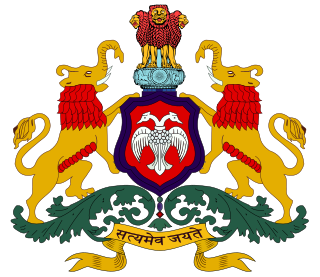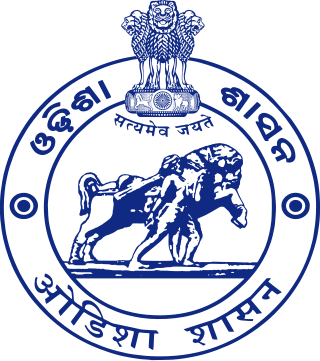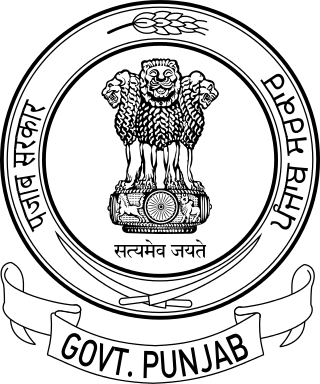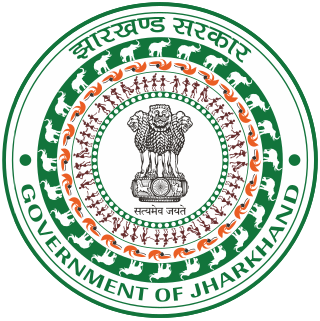
The State Emblem of India is the national emblem of the Republic of India and is used by the union government, many state governments, and other government agencies. The emblem is an adaptation of the Lion Capital of Ashoka, an ancient sculpture dating back to 280 BCE during the Maurya Empire. The statue is a three dimensional emblem showing four lions. It became the emblem of the Dominion of India in December 1947, and later the emblem of the Republic of India. The State Emblem of India is an official seal of the Government of India. It is used as the national emblem of India and appears on official documents, currency and passports.

The national flag of India, colloquially called Tiraṅgā, is a horizontal rectangular tricolour flag, the colours being of India saffron, white and India green; with the Ashoka Chakra, a 24-spoke wheel, in navy blue at its centre. It was adopted in its present form during a meeting of the Constituent Assembly held on 22 July 1947, and it became the official flag of the Dominion of India on 15 August 1947. The flag was subsequently retained as that of the Republic of India. In India, the term "tricolour" almost always refers to the Indian national flag. The flag is based on the Swaraj flag, a flag of the Indian National Congress designed by Pingali Venkayya.

The Ashoka Chakra is an Indian symbol which is a depiction of the Dharmachakra. It is called so because it appears on a number of edicts of Ashoka, most prominent among which is the Lion Capital of Ashoka. The most visible use of the Ashoka Chakra today is at the centre of the Flag of India, where it is rendered in a navy blue colour on a white background, replacing the symbol of charkha of the pre-independence versions of the flag. It is also shown in the Ashoka Chakra medal which is the highest award for gallantry in peace time.

The pillars of Ashoka are a series of monolithic columns dispersed throughout the Indian subcontinent, erected or at least inscribed with edicts by the 3rd Mauryan Emperor Ashoka the Great, who reigned from c. 268 to 232 BCE. Ashoka used the expression Dhaṃma thaṃbhā, i.e. "pillars of the Dharma" to describe his own pillars. These pillars constitute important monuments of the architecture of India, most of them exhibiting the characteristic Mauryan polish. Of the pillars erected by Ashoka, twenty still survive including those with inscriptions of his edicts. Only a few with animal capitals survive of which seven complete specimens are known. Two pillars were relocated by Firuz Shah Tughlaq to Delhi. Several pillars were relocated later by Mughal Empire rulers, the animal capitals being removed. Averaging between 12 and 15 m in height, and weighing up to 50 tons each, the pillars were dragged, sometimes hundreds of miles, to where they were erected.

The Coat of arms of the Republic of Latvia was officially adopted by the Constitutional Assembly of Latvia on 15 June 1921, and entered official use starting on 19 August 1921. It was created using new national symbols, as well as elements of the coats of arms of Polish and Swedish Livonia and of the Duchy of Courland and Semigallia. Thus, the coat of arms combines symbols of Latvian national statehood, as well as symbols of its historical regions. The Latvian national coat of arms was designed by the Latvian artist Rihards Zariņš.

The coat of arms of Montenegro was officially adopted by the law passed in the Parliament on 12 July 2004. It is now the central motif of the flag of Montenegro, as well as the coat of arms of the Armed Forces of Montenegro. It was constitutionally sanctioned by the Constitution proclaimed on 2 October 2007.

The Star of India refers to a group of flags used during the period of the British Raj in the Indian subcontinent. India had a range of flags for different purposes during its existence. The Princely states had their own flags which were to be flown alongside the British flag as a symbol of suzerainty. The official state flag for use on land was the Union Flag of the United Kingdom and it was this flag that was lowered on Independence Day in 1947. The flag of the governor-general of India was defaced with the Star of India. The civil ensign and naval ensign were the Red Ensign or Blue Ensign, respectively, defaced with the Star of India emblem.

The Emblem of Kerala used by Government of Kerala, to represent the state in all its official correspondences. The emblem portrays two elephants guarding the state emblem of India and the Shankh of Sri Padmanabhaswamy according to the history of Kerala.

The Emblem of Karnataka is the state emblem of Karnataka, India. The emblem is based on that of the Kingdom of Mysore is carried on all official correspondences made by the Government of Karnataka.

The Emblem of Tamil Nadu is the official state emblem of Tamil Nadu and is used as the official state symbol of the Government of Tamil Nadu.

The Lion Capital of Ashoka is the capital, or head, of a column erected by the Mauryan emperor Ashoka in Sarnath, India, c. 250 BCE. Its crowning features are four life-sized lions set back to back on a drum-shaped abacus. The side of the abacus is adorned with wheels in relief, and interspersing them, four animals, a lion, an elephant, a bull, and a galloping horse follow each other from right to left. A bell-shaped lotus forms the lowest member of the capital, and the whole 2.1 metres (7 ft) tall, carved out of a single block of sandstone and highly polished, was secured to its monolithic column by a metal dowel. Erected after Ashoka's conversion to Buddhism, it commemorated the site of Gautama Buddha's first sermon some two centuries before.

The Emblem of Andhra Pradesh is the official state emblem of Andhra Pradesh, India.

The Emblem of Odisha is the official seal of the government of the Indian state of Odisha.

The Emblem of Himachal Pradesh is the official state seal used by the Government of Himachal Pradesh and is carried on all official correspondences made by State of Himachal Pradesh. It was adopted by the Government of Himachal Pradesh at the establishment of the state on 25 January 1971. The State of Himachal Pradesh has an Emblem consisting of a mountain ridge over three white fesses, charged with the Aśoka capital.

The Emblem of Punjab is the official state emblem of the State of Punjab, India and it is used as the official symbol of the Government of Punjab, India.

The Emblem of Chhattisgarh is the official seal of the government of the Indian state of Chhattisgarh. It was adopted on 4 September 2001 when Chhattisgarh state was formed from part of Madhya Pradesh.

The Emblem of Jharkhand is the official seal of the government of the Indian state of Jharkhand.

The Emblem of Madhya Pradesh is the official seal of the government of the Indian state of Madhya Pradesh.

The Emblem of Haryana is the official seal of the government of the Indian state of Haryana.



















